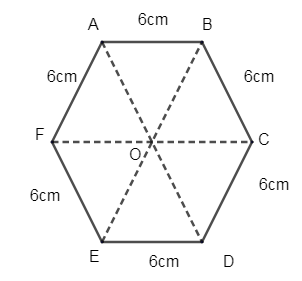
If the side of a regular hexagon is 6cm, then its area will be
(a)108 sq. cm
(b)\[\dfrac{108}{3}\]sq. cm
(c)\[108\sqrt{3}\]sq. cm
(d)\[54\sqrt{3}\]sq. cm
Answer
504.3k+ views
Hint: Draw a hexagon ABCDEF, the diagonals AD, BE and CF divide the hexagon into 6 equal equilateral triangles. Find the area of the equilateral triangle. Using the formula root \[\dfrac{\sqrt{3}}{4}{{a}^{2}}\], where a is the side of the triangle. Thus the area of the hexagon is equal to six times the area of the equilateral triangle.
Complete step-by-step answer:
We have been given the side of the regular hexagon as 6cm. Let us consider ABCDEF as a regular hexagon. Let ‘O’ be the center of the regular hexagon.

Now let us join the diagonals of the hexagons AD, BE and CF.
By the properties of the regular hexagon, the three diagonals divide the hexagon, into 6 congruent equilateral triangles.
Now their equilateral triangle will have the side as 6cm.
We know that the area of the equilateral triangle is given by the formula,
\[A=\dfrac{\sqrt{3}}{4}{{a}^{2}}\]
Here a = side = 6cm
\[\therefore \] Area of one equilateral triangle = \[\dfrac{\sqrt{3}}{4}{{\left( 6 \right)}^{2}}=\dfrac{\sqrt{3}}{4}\times 6\times 6=3\times 3\times \sqrt{3}=9\sqrt{3}\]
Thus we got the area of one equilateral triangle = \[9\sqrt{3}\].
\[\therefore \] Area of the regular hexagon = 6 \[\times \] area of one equilateral triangle.
\[\therefore \] Area of the regular hexagon = \[6\times 9\sqrt{3}=54\sqrt{3}c{{m}^{2}}\]
Thus we got the area of the regular hexagon as \[54\sqrt{3}c{{m}^{2}}\].
\[\therefore \] Option (d) is the correct answer.
Note: We can also find the area of the hexagon using the formula, \[\dfrac{3\sqrt{3}}{2}{{a}^{2}}\].
\[\therefore \] Area of hexagon = \[\dfrac{3\sqrt{3}}{2}\times {{6}^{2}}=\dfrac{3\sqrt{3}}{2}\times 6\times 6=3\sqrt{3}\times 3\times 6=54\sqrt{3}c{{m}^{2}}\].
If you can’t remember the formula, you can solve it by splitting it into equilateral triangles.
Complete step-by-step answer:
We have been given the side of the regular hexagon as 6cm. Let us consider ABCDEF as a regular hexagon. Let ‘O’ be the center of the regular hexagon.

Now let us join the diagonals of the hexagons AD, BE and CF.
By the properties of the regular hexagon, the three diagonals divide the hexagon, into 6 congruent equilateral triangles.
Now their equilateral triangle will have the side as 6cm.
We know that the area of the equilateral triangle is given by the formula,
\[A=\dfrac{\sqrt{3}}{4}{{a}^{2}}\]
Here a = side = 6cm
\[\therefore \] Area of one equilateral triangle = \[\dfrac{\sqrt{3}}{4}{{\left( 6 \right)}^{2}}=\dfrac{\sqrt{3}}{4}\times 6\times 6=3\times 3\times \sqrt{3}=9\sqrt{3}\]
Thus we got the area of one equilateral triangle = \[9\sqrt{3}\].
\[\therefore \] Area of the regular hexagon = 6 \[\times \] area of one equilateral triangle.
\[\therefore \] Area of the regular hexagon = \[6\times 9\sqrt{3}=54\sqrt{3}c{{m}^{2}}\]
Thus we got the area of the regular hexagon as \[54\sqrt{3}c{{m}^{2}}\].
\[\therefore \] Option (d) is the correct answer.
Note: We can also find the area of the hexagon using the formula, \[\dfrac{3\sqrt{3}}{2}{{a}^{2}}\].
\[\therefore \] Area of hexagon = \[\dfrac{3\sqrt{3}}{2}\times {{6}^{2}}=\dfrac{3\sqrt{3}}{2}\times 6\times 6=3\sqrt{3}\times 3\times 6=54\sqrt{3}c{{m}^{2}}\].
If you can’t remember the formula, you can solve it by splitting it into equilateral triangles.
Recently Updated Pages
Master Class 10 Computer Science: Engaging Questions & Answers for Success

Master Class 10 Maths: Engaging Questions & Answers for Success

Master Class 10 English: Engaging Questions & Answers for Success

Master Class 10 General Knowledge: Engaging Questions & Answers for Success

Master Class 10 Science: Engaging Questions & Answers for Success

Master Class 10 Social Science: Engaging Questions & Answers for Success

Trending doubts
The singular of lice is louse A Yes B No class 8 english CBSE

Summary of the poem Where the Mind is Without Fear class 8 english CBSE

How many ounces are in 500 mL class 8 maths CBSE

Advantages and disadvantages of science

1 meter is equal to how many feet class 8 maths CBSE

In Indian rupees 1 trillion is equal to how many c class 8 maths CBSE




